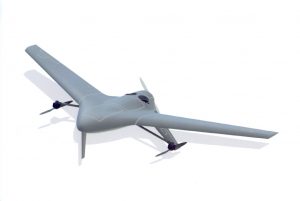
DEFEA 2023 – Archytas, the new UAV by Hellenic Airspace Industries
With its first flight planned in over one year, the Archytas unmanned air vehicle was definitively the star of the Hellenic Aerospace Industry stand at DEFEA 2023
Not many information were available as the project is still in its definition phase, however the half-size model of the Archytas, the new UAV being proposed by Hellenic Aerospace Industries (HAI). The airframe features a blended wing body with high swept wings attached to the fuselage; inverted-V rear control surfaces and a vertical fin at the front ensure manoeuvrability. Propulsion is provided by a thermal engine located at the rear that activates a two-blade pushing propeller.

The Archytas is VTOL aircraft, two rotors being deployed in the take-off and landing phases, rotors coming mostly out of the wings shadow. However to optimise flight performances, these retract nearly entirely into the fuselage.
This configuration ensures maximum flexibility of use. Although no details were provided, it is quite obvious that the two rotors will be used only for a few manoeuvres, as they are activated by electric motors powered by batteries, probably located in the lower part of the fuselage.

The model was not showing any sign of landing gear, but this will be definitely needed considering the aerodynamic appendices located under the fuselage.
The UAV will be used for surveillance, observation or reconnaissance missions, and will be able to carry different types of payloads. Maximum payload is 14 kg, maximum take-off weight not being announced. The wing has a 6.4 metres span, operational ceiling being 27,000 ft. Maximum speed is 158 km/h, cruise speed 120 km/h and stall speed 74 km/h. The Archytas has an endurance of four hours.
As said the configuration is not yet frozen, therefore the real airframe might well be somewhat different from the concept model seen at DEFEA. According to HAI the first flight might take place in the second half of 2024.
Photos by P. Valpolini

